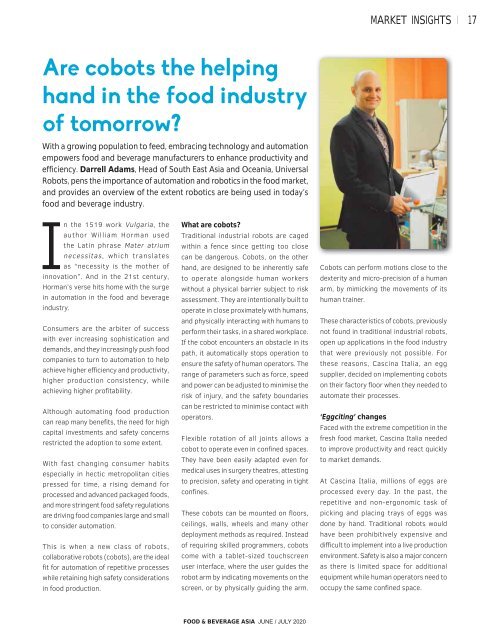Food & Beverage Asia June/July 2020
Food & Beverage Asia (FBA) is the leading source of food and beverage news in Asia since 2002. FBA delivers a comprehensive view of the food and beverage landscape, spanning across the latest health and nutrition trends and industry innovations in ingredients, recipe formulations, food science, sustainability, packaging, and automation, as well as advancements in agri and food-tech.
Food & Beverage Asia (FBA) is the leading source of food and beverage news in Asia since 2002. FBA delivers a comprehensive view of the food and beverage landscape, spanning across the latest health and nutrition trends and industry innovations in ingredients, recipe formulations, food science, sustainability, packaging, and automation, as well as advancements in agri and food-tech.
Create successful ePaper yourself
Turn your PDF publications into a flip-book with our unique Google optimized e-Paper software.
MARKET INSIGHTS<br />
17<br />
Are cobots the helping<br />
hand in the food industry<br />
of tomorrow?<br />
With a growing population to feed, embracing technology and automation<br />
empowers food and beverage manufacturers to enhance productivity and<br />
efficiency. Darrell Adams, Head of South East <strong>Asia</strong> and Oceania, Universal<br />
Robots, pens the importance of automation and robotics in the food market,<br />
and provides an overview of the extent robotics are being used in today’s<br />
food and beverage industry.<br />
In the 1519 work Vulgaria, the<br />
author William Horman used<br />
the Latin phrase Mater atrium<br />
necessitas, which translates<br />
as “necessity is the mother of<br />
innovation”. And in the 21st century,<br />
Horman’s verse hits home with the surge<br />
in automation in the food and beverage<br />
industry.<br />
Consumers are the arbiter of success<br />
with ever increasing sophistication and<br />
demands, and they increasingly push food<br />
companies to turn to automation to help<br />
achieve higher efficiency and productivity,<br />
higher production consistency, while<br />
achieving higher profitability.<br />
Although automating food production<br />
can reap many benefits, the need for high<br />
capital investments and safety concerns<br />
restricted the adoption to some extent.<br />
With fast changing consumer habits<br />
especially in hectic metropolitan cities<br />
pressed for time, a rising demand for<br />
processed and advanced packaged foods,<br />
and more stringent food safety regulations<br />
are driving food companies large and small<br />
to consider automation.<br />
This is when a new class of robots,<br />
collaborative robots (cobots), are the ideal<br />
fit for automation of repetitive processes<br />
while retaining high safety considerations<br />
in food production.<br />
What are cobots?<br />
Traditional industrial robots are caged<br />
within a fence since getting too close<br />
can be dangerous. Cobots, on the other<br />
hand, are designed to be inherently safe<br />
to operate alongside human workers<br />
without a physical barrier subject to risk<br />
assessment. They are intentionally built to<br />
operate in close proximately with humans,<br />
and physically interacting with humans to<br />
perform their tasks, in a shared workplace.<br />
If the cobot encounters an obstacle in its<br />
path, it automatically stops operation to<br />
ensure the safety of human operators. The<br />
range of parameters such as force, speed<br />
and power can be adjusted to minimise the<br />
risk of injury, and the safety boundaries<br />
can be restricted to minimise contact with<br />
operators.<br />
Flexible rotation of all joints allows a<br />
cobot to operate even in confined spaces.<br />
They have been easily adapted even for<br />
medical uses in surgery theatres, attesting<br />
to precision, safety and operating in tight<br />
confines.<br />
These cobots can be mounted on floors,<br />
ceilings, walls, wheels and many other<br />
deployment methods as required. Instead<br />
of requiring skilled programmers, cobots<br />
come with a tablet-sized touchscreen<br />
user interface, where the user guides the<br />
robot arm by indicating movements on the<br />
screen, or by physically guiding the arm.<br />
Cobots can perform motions close to the<br />
dexterity and micro-precision of a human<br />
arm, by mimicking the movements of its<br />
human trainer.<br />
These characteristics of cobots, previously<br />
not found in traditional industrial robots,<br />
open up applications in the food industry<br />
that were previously not possible. For<br />
these reasons, Cascina Italia, an egg<br />
supplier, decided on implementing cobots<br />
on their factory floor when they needed to<br />
automate their processes.<br />
‘Eggciting’ changes<br />
Faced with the extreme competition in the<br />
fresh food market, Cascina Italia needed<br />
to improve productivity and react quickly<br />
to market demands.<br />
At Cascina Italia, millions of eggs are<br />
processed every day. In the past, the<br />
repetitive and non-ergonomic task of<br />
picking and placing trays of eggs was<br />
done by hand. Traditional robots would<br />
have been prohibitively expensive and<br />
difficult to implement into a live production<br />
environment. Safety is also a major concern<br />
as there is limited space for additional<br />
equipment while human operators need to<br />
occupy the same confined space.<br />
FOOD & BEVERAGE ASIA JUNE / JULY <strong>2020</strong>


















